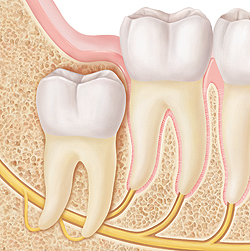Understanding Impacted Wisdom Teeth
Understanding Impacted Wisdom Teeth
Wisdom teeth that can’t fully break through the gum (erupt) are called impacted. These teeth can grow in almost any direction, including:
Straight upward (vertical position), but without room to erupt into a healthy position.
Angled away from the other teeth (distoangular position).
Parallel to the gumline (horizontal position).
Angled in toward the other teeth (mesioangular position).
|
Problems caused by impacted teeth
Impacted wisdom teeth can cause sudden (acute) problems, ongoing (chronic) problems, or no problems at all. Removing the teeth before symptoms occur can prevent or reduce future problems. Dental X-rays can help your dentist find existing problems. X-rays may also help show whether your wisdom teeth are likely to cause problems in the future. But it’s not always clear whether your wisdom teeth will give you trouble. Possible problems include:
Gum infection (acute pericoronitis). As the tooth breaks through the gum, the gum can become infected, causing pain, swelling, and sometimes bleeding.
Chronic gum (periodontal) disease. Problems brushing and flossing at the back of the mouth can lead to gum disease. Or it may occur if bacteria and food debris collect under the gum tissue covering an impacted tooth. Gum disease can lead to loss of the nearby molar.
Tooth decay. Wisdom teeth can be hard to clean because they’re at the back of the mouth. This can lead to decay of both the wisdom tooth and the tooth next to it.
Crowding. An impacted tooth can push on nearby teeth, forcing them out of alignment. This can interfere with your bite. Crowding can also damage individual teeth.
Poor position. A tooth that grows pointing in toward the tongue or out toward the cheek can irritate nearby tissue. It may interfere with your bite. Problems can also occur if there is no matching tooth in the opposite jaw for the tooth to bite on.
Cysts and tumors. A tooth that’s embedded in the bone is encased in a sac. This sac can fill with fluid, forming a cyst. A cyst can expand and destroy surrounding bone. In rare cases, a tumor forms in this area.
Updated:
July 29, 2017
Sources:
Contemporary Oral and Maxillofacial Surgery. Hupp, J. 2014, ed. 6, pp. 144-49, 150-52.
Reviewed By:
Kapner, Michael, DDS,Sather, Rita, RN

